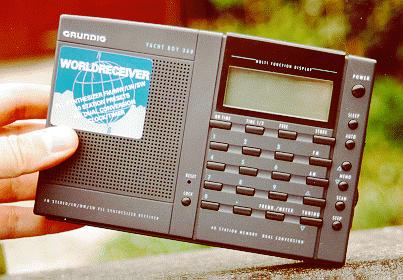
Year Introduced: 1995
Power: 6 AA Batteries, AC adaptor optional
Size: 178 by 120 by 40 mm
Weight: 598 grams
Price: 245 Dutch Guilders. Not seen in North America. Coverage: LW, MW, SW, FM
Value Rating star:




This review was compiled independently. The Medium Wave Circle and Radio Netherlands has no financial connection with R.L. Drake, the manufacturer of this receiver.
The Yacht Boy 360 is a “paperback book” portable, slightly larger and heavier than its competition, the Sony ICF-SW40. Both are designed for the discerning traveller interested in more than average performance but also not too keen on spending vast sums for minaturisation. They are designed only for broadcast band listening; neither has SSB for listening to maritime communications or radio amateurs.
The Grundig Yacht Boy 360 is slightly larger than the SW40 at 178 by 120 by 40 mm and it is heavier, 598 grams including six penlight batteries that snap into the back. The radio comes complete with a simulated leather carrying case and a book about shortwave written by Deutsche Welle’s engineering department.
The Grundig Yacht Boy 360 is made in the Peoples’ Republic of China to the German manufacturers’ specifications. Because it is slightly larger and uses 6 batteries, the built-in amplifier delivers a richer, fuller sound than the Sony. But it is more expensive to run because the batteries last about 26 hours. The AC power supply is an optional extra.
Here in The Netherlands, you pay about 30 US dollars more for the Yacht Boy 360. You get keypad tuning but no rotary tuning knob, and 40 memories for favourite stations, so twice as many as the Sony. Tuning is very simple. You tap in the frequency of a shortwave station, lets say 9 8 9 5, and then hit an enter key. The radio tunes to that channel. If you tap in 49 and the enter key, the radio goes to the middle of the 49 metre band. Tuning is in 1 or 9 kHz on longwave, 1 or 5 kHz on shortwave, and 1, 9 or 10 kHz on mediumwave. Coverage of the radio is less restricted than the Sony. For instance there is coverage of the extended portion of the mediumwave dial up to 1710 kHz.
SHORTWAVE COVERAGE
On shortwave reception starts at 1720 and goes up continuously to 29995 kHz, slightly different than specified in the manual.
There are also two timers on this radio, plus a sleep function in 10 minutes steps down from an hour. There’s a simple scanning system which stops when it hits a strong station, or you can scan what’s been retained in the memory. The radio has a lighted dial for bedside listening, and a two position tone control.
WHICH IS BETTER?
Now to the performance test. Here the Grundig is more sensitive and that means in Europe listening to shortwave after dark has to be with the telescopic whip fully collapsed. We’re quite close to a powerful mediumwave station here in Hilversum and whereas there is noticable breakthrough of 747 and 1008 kHz on parts of the SW dial using the Yacht Boy 360, these problems are not present on the Sony ICF-SW-40. The shape of the bandwidth filter on the Sony turns out to be slightly better. Neither of the radios needs an external antenna in Europe… that might be different if you are living in a low signal strength area like New Zealand.
We think the Grundig sounds better but uses more battery power in doing so and it has coverage of the extended mediumwave band. The Sony will appeal to those familiar with analogue tuning dials and infact its probably easier to jump around the dial using this method than the keypad system used on the Grundig… it depends on what you’re used to. The Sony ICF-SW40 retails in the high street at 199 Dutch Guilders in Holland, which is US$117. The Grundig Yacht Boy is more expensive at 249 Guilders, that’s US$146.
This review first appeared on the Radio Netherlands website.